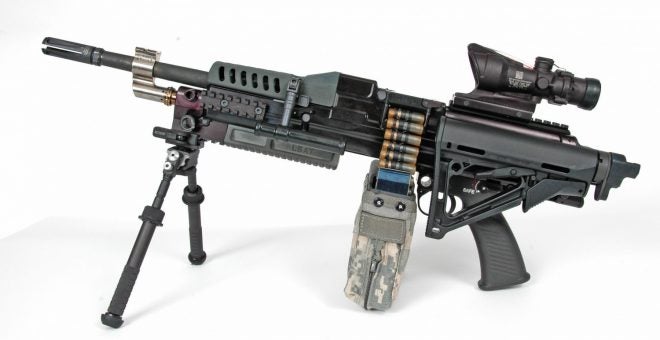The NGSAR is dead, long live the NGSW. We haven’t heard much from the US Army about its next generation infantry weapons programme since the announcement of six contract awards for the Next Generation Squad Automatic Rifle (NGSAR) back in June. Just a week before the Association of the United States Army (AUSA)’s 2018 annual meeting Army Contracting Command has released a new draft Next Generation Squad Weapons Prototype Opportunity Notice (PON).
On the 25th June, the US Army awarded six Other Transaction Agreements (or OTAs) to five companies: AAI Corproation Textron Systems, FN America (awarded two contracts – likely for the FN HAMR and a belt fed gun), General Dynamics, PCP Tactical and SIG Sauer.
The new ‘draft’ PON, released on 4th October, is intended as a request for proposals and feedback on the requirements from interested vendors. The draft PON’s FedBizOps page explains the reasoning behind the release of the draft:
The Government is seeking Industry questions and comments to assist in shaping the NGSW program strategy to rapidly develop and deliver prototype weapons and ammunition. The intent is to engage Industry early in order to provide the best materiel solution for the NGSW program. Additionally, the Government intends to hold an Industry Day to provide program overview, clarification, and address questions.
Curiously, this new ‘draft’ PON appears to supersede the previous NGSAR PON, as it calls for both a rifle and an automatic rifle. While Army Contracting Command claim to be seeking to “engage industry early” it seems that the programme is being restarted. We have contacted Army Contracting Command, New Jersey, for confirmation of this, the earlier NGSAR contract award page has not been updated to reflect any cancellation of previous awards.
What Does the New PON Ask For?
The new ‘draft’ PON seeks both an NGSW-R, the planned replacement for the M4/M4A1 carbine, and a NGSW-AR (Automatic Rifle) to replace the M249 Squad Automatic Weapon (SAW).
The new PON also differs in that it is seeking two weapon systems that can fire “Government provided 6.8 millimeter projectiles” with vendors expected to develop a cartridge, which fits defined lethality requirements, using the government projectile. The two weapon platforms must also have magazine interchangeability – if the NGSW-AR feeds from magazines.
The draft PON defines the two weapons in more detail but gives no indication of requirements for weight, length or barrel length:
“NGSW-R” refers to a prototype 6.8 millimeter rifle with sling, flash hider, suppressor, cleaning kit, flash hider/suppressor removal tool, and quantities of magazines required to provide a minimum of 210 stowed rounds.
“NGSW-AR” refers to a prototype 6.8 millimeter automatic rifle with bi-pod, sling [author’s emphasis], flash hider, suppressor, cleaning kit, flash hider/suppressor removal tool, and quantities of magazines/drums/belts/other required to provide a minimum of 210 stowed rounds.
The PON leaves the ammunition carriage system of the NGSW-AR open while stipulating magazines for the NGSW-R. Both weapons, however, must use the same round. The PON includes a list of characteristics the two platforms must have:
The NGSW-R and the NGSW-AR prototypes shall:
a. allow for ambidextrous operation and controls;
b. include a removable flash hider, suppressor, and a tool for removal after firing or for
maintenance;
c. include a tactical carrying sling with quick release attachments;
d. include selection positions for Safe, Semi-Automatic Firing, and Automatic Firing
modes;
e. be resistant to corrosion, abrasion, impact and chemical, biological, radiological and
nuclear defense (CBRNE) contaminants, decontaminants, battlefield-chemicals,
electromagnetic pulse and cyber-attacks;
f. reduce visual detection via a neutral non-reflective, non-black color not lighter than
Light Coyote 481 and not darker than Coyote 499;
g. function in all environments and weather conditions, including marine, high
humidity, rain, and desert conditions;
h. be compatible with combat clothing (including body armor and Modular Lightweight
Load-carrying Equipment), CBRNE, wet weather, and cold weather gear;
i. provide interchangeable magazines between both weapons if NGSW-AR utilizes a
magazine; and
j. include MIL-STD-1913 equivalent rails capable of mounting Rifle Combat Optic,
Close Combat Optic, Aiming Laser, Family of Weapon Sights–Individual, Squad-Fire
Control and other legacy enablers.
While we can’t comment on the ammunition requirement fully as this is set at Distribution F, and not freely available, the draft PON appears to dictate the weapon’s ammunition by stipulating a specific projectile. The PON states that the government’s new ‘6.8MM GENERAL PURPOSE (GP)’ projectile, designated the XM1186, must be used to develop a round that will provide “all-purpose solutions for combat, limited training, and basic qualification.” In a change from the previous PON the Government also states that submitting vendors may work with the Government-owned Contractor-operated Lake City Army Ammunition Plant may be used as a subcontractor to work on ammunition development.
Successful vendors will have to supply “50 NGSW-R weapons, 50 NGSW-AR weapons, 850,000 rounds of ammunition, spare parts, test barrels, tools/gauges/accessories, and engineering support” in the space of 27 months. Interestingly, vendors will also have to supply the full technical data package for both weapons and the ammunition.
Industry vendors have until the 7th December to submit their question and comments on the draft PON, following that the Army Contracting Command will probably publish an official PON and will subsequently hold an Industry Day to provide program overview, clarification, and address questions.
 Your Privacy Choices
Your Privacy Choices
